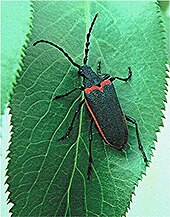|
Lepturinae
 Lepturinae, the lepturine beetles, is a subfamily of the longhorn beetle family (Cerambycidae), containing about 150 genera worldwide. This lineage is most diverse in the Northern Hemisphere. Until recently the subfamily Necydalinae was included within the lepturines, but this has been recently recognized as a separate subfamily. Nine tribes are usually recognized today,[1] with a tenth, Caraphiini, created in 2016.[2] A few genera are of uncertain placement within the subfamily. Usually among the smaller members of their family, these beetles are of a slender shape – particularly the thorax is markedly less wide than the wings, while the elytra tips are often pointed. They differ from most other longhorn beetles in that the antennae are not directly adjacent to the compound eyes. Hence, the latter are generally oval in outline, rather than having an indentation where the antennae originate, or even being divided by them. In addition, sexual dichromatism is not infrequently seen in lepturines; usually, longhorn beetles are not dimorphic or only have longer antennae in males. Tribes and generaLepturinae contains the following genera:[2][1][3]    Tribe Caraphiini
Tribe Desmocerini Blanchard, 1845
Tribe Encyclopini LeConte, 1873Tribe Lepturini Latreille, 1802Selected genera: (complete list is on the Lepturini page)
Tribe Oxymirini Danilevsky, 1997
Tribe Rhagiini Kirby, 1837
Tribe Rhamnusiini Sama, 2009
Tribe Sachalinobiini Danilevsky, 2010Tribe Teledapini Pascoe, 1871Tribe Xylosteini Reitter, 1913
References
|
||||||||||||||||||||||||||||||||||||||
